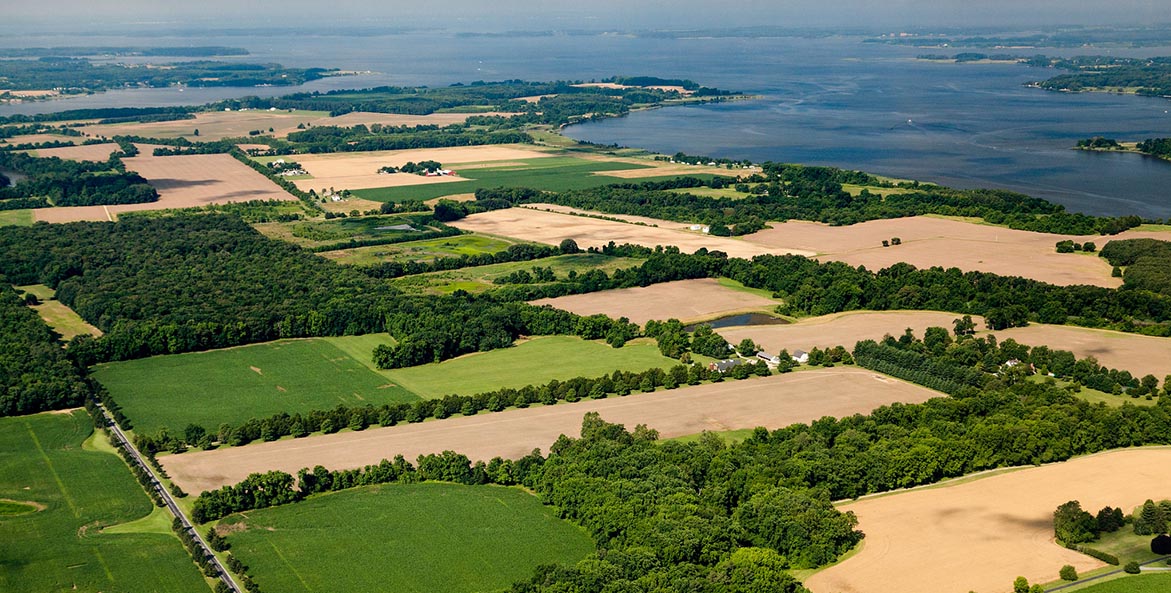Nutrient runoff from farms is the largest source of pollution in our waters. Reducing it is also the biggest opportunity to restore them. That’s why this year’s Farm Bill debate in Congress is so important—and why it’s essential the U.S. Department of Agriculture (USDA) plays a leadership role in restoring the Chesapeake Bay and its tributaries.
Passed only once every five years or so, the federal Farm Bill is a package of legislation that has far-reaching impacts on farm communities and the way food is grown—and in turn, the quality of our waterways. When soils and fertilizers wash off of farmland, they can smother waterways with sediment and feed large algal blooms that deplete the water of oxygen when they die and decompose.
U.S. Department of Agriculture (USDA) conservation programs included in the Farm Bill offer farmers nationwide on-the-ground technical support and financial assistance to adopt conservation practices that help stop this pollution at its source. By focusing on practices like streamside forested buffers—which form natural filters that keep soil and nutrients out of local waterways—and practices that boost soil health, like rotational grazing, USDA can help interested farmers improve water quality. Many of these same practices also fight climate change and build resiliency to its effects—like hotter temperatures, droughts, and extreme rainfall—that are already hitting farmers hard.
Unfortunately, these practices aren’t getting on the ground fast enough. The Chesapeake Clean Water Blueprint’s deadline for cutting pollution from agriculture and other sources is just two years away, but the Bay states are not on track to meet it. Pennsylvania has the largest gap to close and is the furthest behind.
USDA can jumpstart progress in Pennsylvania and the other states by making bold investments in the Chesapeake Bay States’ Partnership Initiative it created last spring to increase fiscal year 2022 funding for conservation in this region.
Congress can do its part in the 2023 Farm Bill by increasing funding for these conservation programs, making policy changes to ensure the programs are efficiently and effectively implemented, and encouraging farmers to adopt practices that provide multiple environmental benefits.
These investments aren’t just good for water quality—they pay economic dividends to the farmers who enroll in these programs and spur business and job growth in their communities.
To maximize these benefits and give USDA the resources to be a cleanup leader, CBF is urging Congress to include these priorities in the 2023 Farm Bill:
- Increase funding to enroll more farmers in conservation programs and provide them with the technical assistance they need to succeed. At minimum, provide the full funding boost provided in the Inflation Reduction Act.
- Encourage regenerative agriculture by increasing incentives and technical assistance in the Environmental Quality Incentives Program (EQIP), the Federal Crop Insurance Program, and Conservation Stewardship Program (CSP) for farmers willing to implement regenerative systems.
- Educate and expand the next generation of conservation experts by partnering with educational institutions to train and certify them, support existing staff with training and incentives, and make it easier for farmers to get technical assistance from non-federal sources.
- Reinvigorate the Conservation Reserve Enhancement Program (CREP), which has historically been the main source of funding and technical assistance for farmers to install streamside forested buffers. Congress can do that by making it easier for farmers to enroll, simplifying the process for participating states to adopt new incentives, and offering more attractive incentives to landowners. Buffers are among the most cost-effective ways for states to meet their Blueprint commitments.
- Keep the Bay watershed as one of eight Critical Conservation Areas in the Regional Conservation Partnership Program (RCPP), which is a valuable tool for testing innovative approaches to conservation. In addition, revamp the RCPP to give lead partners more financial flexibility; set timelines for USDA to enter into partnerships and reimburse partners; and streamline the project application, contracting, and implementation processes.
- Increase support for historically underserved farmers, including beginning farmers, veterans, and farmers from socially disadvantaged groups that have historically been subject to discrimination by USDA.
- Invest more in local markets and food processing so farmers have more ways to sell food locally.
See CBF's 2023 Farm Bill Policy Priorities document for more details.




